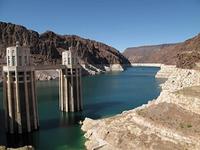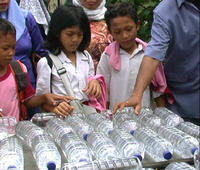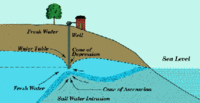-
Increase in groundwater demands due to climate change
As precipitation becomes less frequent due to climate change, lake and reservoir levels will drop and people will increasingly turn to groundwater for agricultural, industrial, and drinking water needs; the resource accounts for nearly half of all drinking water worldwide, but recharges at a much slower rate than aboveground water sources and in many cases is nonrenewable
-
-
Poultry feathers-based filters remove arsenic from water
Thousands of people die each year in developing countries from drinking arsenic-contaminated water; researchers develop inexpensive filters made from the modified protein (keratin) in poultry feathers to remove arsenic from drinking water
-
-
U.S. water shortages loom

More than 1 in 3 counties in the United States could face a “high” or “extreme” risk of water shortages due to climate change by the middle of the twenty-first century; 7 in 10 of the more than 3,100 U.S. counties could face “some” risk of shortages of fresh water for drinking, farming, and other uses
-
-
Proposed EPA budget cuts funding from clean air and water grants
President Obama’s latest proposed budget for fiscal year 2013 cuts $105 million from the Environmental Protection Agency’s (EPA) budget, primarily from funds aimed at treating wastewater and drinking water
-
-
A nano method to clean polluted water
Decontaminating polluted waste water costs millions, but a new discovery by scientists at the University of Brighton could result in huge savings as well as delivering safer, cleaner water
-
-
Collecting rainwater could save U.S. residents $90 million a year

Simply collecting rainwater could save U.S. residents millions of dollars each year on their water bills and drastically cut down on water consumption; a new study by the Natural Resources Defense Council examined the potential cost-savings in eight U.S. cities and found that residents could collectively save $90 million or more annually
-
-
Groundwaterin some parts of U.S. susceptible to radium contamination
A recent U.S. Geological Survey (USGS) study found that groundwater in aquifers on the East Coast and in the Central United States has the highest risk of contamination from radium, a naturally occurring radioactive element and known carcinogen
-
-
GAO: critical infrastructure operators need more coherent regulations
A recent Government Accountability Office (GAO) report found that the bulk of U.S. critical infrastructure is inadequately protected as operators lack a coherent set of guidelines
-
-
Protecting U.S. water supplies

Aside from possible cyberatacks on water utilities, security officials are worried that terrorists could contaminate water supplies with volatile chemicals that can poison thousands of individuals and even cause explosions; DHS warned local water utilities of “backpressure” — a simple tactic terrorists could use to introduce a chemical or biological agent into the water supply and spread it over long distances without immediate detection
-
-
DHS investigates attacks on New Jersey water supply

DHS agents and local authorities in New Jersey are investigating a series of attacks on the West Milford water system; since July there have been more than fifteen attacks on local water and sewage facilities that in some instances have resulted in sewage flooding the street or losses in service all together
-
-
Solar UV disinfects drinking water

More than 800 million people around the world lack access to clean water; the water available for people to drink in many developing countries has not been treated to remove contaminants, including pathogenic microorganisms; half of the world’s hospital beds are occupied by people who are sickened by the water they drink; Purdue University researchers have invented a water-disinfection system that uses the sun’s ultraviolet radiation to inactivate waterborne pathogens
-
-
Global water market could hit $800 billion by 2035
Analysts are predicting that the global market for water could grow dramatically over the next two decades, with some projecting a $1 trillion market in 2020; “Water is the fastest growing market at the moment, with a size of $500 billion globally,” said Harri Kerminen, the president and CEO of Finnish chemical firm Kemira
-
-
Maintaining water quality
Scientists at Kansas State University and seven other collaborating institutions were recently awarded $3.3 million from the National Science Foundation (NSF) to conduct a-large scale study of how stream organisms influence water quality across North America
-
-
Cyber attacks on U.S. are becoming more lethal
The head of the U.S. Cyber Command said that cyber attacks on the United States are escalating from large-scale theft and disruption of computer operations to more lethal attacks that destroy systems and physical equipment
-
-
Saltwater intrusion threatens South Florida’s water supplies

South Florida’s water supply is becoming increasingly endangered by saltwater that is steadily seeping in from the ocean and contaminating supplies; despite the best efforts of local communities to stop the problem, saltwater intrusion is spreading
-
More headlines
The long view
Water Wars: A Historic Agreement Between Mexico and US Is Ramping Up Border Tension
As climate change drives rising temperatures and changes in rainfall, Mexico and the US are in the middle of a conflict over water, putting an additional strain on their relationship. Partly due to constant droughts, Mexico has struggled to maintain its water deliveries for much of the last 25 years, deliveries to which it is obligated by a 1944 water-sharing agreement between the two countries.
